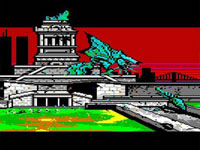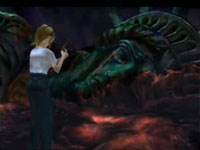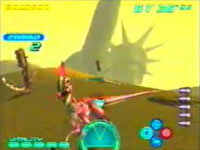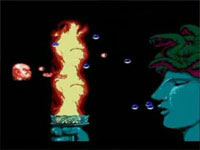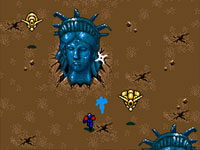- CLASSIC MAGAZINES
- REVIEW CREW
A show recapping what critics thought back
when classic games first came out! - NEXT GENERATION'S BEST & WORST
From the worst 1-star reviews to the best
5-stars can offer, this is Next Generation! - NINTENDO POWER (ARCHIVE)
Experience a variety of shows looking at the
often baffling history of Nintendo Power! - MAGAZINE RETROSPECTIVE
We're looking at the absolutely true history of
some of the most iconic game magazines ever! - SUPER PLAY'S TOP 600
The longest and most ambitious Super NES
countdown on the internet! - THEY SAID WHAT?
Debunking predictions and gossip found
in classic video game magazines! - NEXT GENERATION UNCOVERED
Cyril is back in this spin-off series, featuring the
cover critic review the art of Next Generation! - HARDCORE GAMER MAGAZING (PDF ISSUES)
Download all 36 issues of Hardcore Gamer
Magazine and relive the fun in PDF form!
- REVIEW CREW
- ELECTRONIC GAMING MONTHLY
- ELECTRONIC GAMING MONTHLY RANKS
From Mario to Sonic to Street Fighter, EGM
ranks classic game franchises and consoles! - ELECTRONIC GAMING MONTHLY BEST & WORST
Counting down EGM’s best and worst reviews
going year by year, from 1989 – 2009! - ELECTRONIC GAMING BEST & WORST AWARDS
11-part video series chronicling the ups and
downs of EGM’s Best & Worst Awards!
- ELECTRONIC GAMING MONTHLY RANKS
- GAME HISTORY
- GAME OVER: STORY BREAKDOWNS
Long-running series breaking down game
stories and analyzing their endings! - A BRIEF HISTORY OF GAMING w/ [NAME HERE]
Real history presented in a fun and pithy
format from a variety of game historians! - THE BLACK SHEEP
A series looking back at the black sheep
entries in popular game franchises! - INSTANT EXPERT
Everything you could possibly want to know
about a wide variety of gaming topics! - FREEZE FRAME
When something familiar happens in the games
industry, we're there to take a picture! - I'VE GOT YOUR NUMBER
Learn real video game history through a series
of number-themed episodes, starting at zero! - GREAT MOMENTS IN BAD ACTING
A joyous celebration of some of gaming's
absolute worst voice acting!
- GAME OVER: STORY BREAKDOWNS
- POPULAR SHOWS
- DG NEWS w/ LORNE RISELEY
Newsman Lorne Riseley hosts a regular
series looking at the hottest gaming news! - REVIEW REWIND
Cyril replays a game he reviewed 10+ years
ago to see if he got it right or wrong! - ON-RUNNING FEUDS
Defunct Games' longest-running show, with
editorials, observations and other fun oddities! - DEFUNCT GAMES QUIZ (ARCHIVE)
From online quizzes to game shows, we're
putting your video game knowledge to the test!- QUIZ: ONLINE PASS
Take a weekly quiz to see how well you know
the news and current gaming events! - QUIZ: KNOW THE GAME
One-on-one quiz show where contestants
find out if they actually know classic games! - QUIZ: THE LEADERBOARD
Can you guess the game based on the classic
review? Find out with The Leaderboard!
- QUIZ: ONLINE PASS
- DEFUNCT GAMES VS.
Cyril and the Defunct Games staff isn't afraid
to choose their favorite games and more! - CYRIL READS WORLDS OF POWER
Defunct Games recreates classic game
novelizations through the audio book format!
- DG NEWS w/ LORNE RISELEY
- COMEDY
- GAME EXPECTANCY
How long will your favorite hero live? We crunch
the numbers in this series about dying! - VIDEO GAME ADVICE
Famous game characters answer real personal
advice questions with a humorous slant! - FAKE GAMES: GUERILLA SCRAPBOOK
A long-running series about fake games and
the people who love them (covers included)! - WORST GAME EVER
A contest that attempts to create the worst
video game ever made, complete with covers! - LEVEL 1 STORIES
Literature based on the first stages of some
of your favorite classic video games! - THE COVER CRITIC
One of Defunct Games' earliest shows, Cover
Critic digs up some of the worst box art ever! - COMMERCIAL BREAK
Take a trip through some of the best and
worst video game advertisements of all time! - COMIC BOOK MODS
You've never seen comics like this before.
A curious mix of rewritten video game comics!
- GAME EXPECTANCY
- SERIES ARCHIVE
- NINTENDO SWITCH ONLINE ARCHIVE
A regularly-updated list of every Nintendo
Switch Online release, plus links to review! - PLAYSTATION PLUS CLASSIC ARCHIVE
A comprehensive list of every PlayStation
Plus classic release, including links! - RETRO-BIT PUBLISHING ARCHIVE
A regularly-updated list of every Retro-Bit
game released! - REVIEW MARATHONS w/ ADAM WALLACE
Join critic Adam Wallace as he takes us on a
classic review marathon with different themes!- DEFUNCT GAMES GOLF CLUB
Adam Wallace takes to the links to slice his way
through 72 classic golf game reviews! - 007 IN PIXELS
Adam Wallace takes on the world's greatest spy
as he reviews 15 weeks of James Bond games! - A SALUTE TO VAMPIRES
Adam Wallace is sinking his teeth into a series
covering Castlevania, BloodRayne and more! - CAPCOM'S CURSE
Adam Wallace is celebrating 13 days of Halloween
with a line-up of Capcom's scariest games! - THE FALL OF SUPERMAN
Adam Wallace is a man of steel for playing
some of the absolute worst Superman games! - THE 31 GAMES OF HALLOWEEN
Adam Wallace spends every day of October afraid
as he reviews some of the scariest games ever! - 12 WEEKS OF STAR TREK
Adam Wallace boldly goes where no critic has
gone before in this Star Trek marathon!
- DEFUNCT GAMES GOLF CLUB
- DAYS OF CHRISTMAS (ARCHIVE)
Annual holiday series with themed-episodes
that date all the way back to 2001!- 2015: 30 Ridiculous Retro Rumors
- 2014: 29 Magazines of Christmas
- 2013: 29 Questionable Power-Ups of Christmas
- 2012: 34 Theme Songs of Christmas
- 2011: 32 Game Endings of Christmas
- 2010: 31 Bonus Levels of Christmas
- 2009: 30 Genres of Christmas
- 2008: 29 Controls of Christmas
- 2007: 34 Cliches of Christmas
- 2006: 33 Consoles of Christmas
- 2005: 32 Articles of Christmas
- 2004: 31 Websites of Christmas
- 2003: 29 Issues of Christmas
- 2002: 28 Years of Christmas
- 2001: 33 Days of Christmas
- NINTENDO SWITCH ONLINE ARCHIVE
- REVIEW ARCHIVE
- FULL ARCHIVE
Destroying Lady Liberty
CHAPTER 3: LITTLE GREEN MEN RAVISH BIG GREEN WOMAN
(AND OTHER STRANGENESS)
The remaining games below employ the Statue of Liberty in bizarre fashion and do not seem to carry the same weight of implied social commentary as the games already mentioned. Manhunter: New York (1988, Amiga): Sierra made memorable adventure titles. This is not one of them. Cryptic puzzles and a minimal story line hinder this adventure that places you as a toady for an alien race that has invaded the earth for unknown reasons. You take your marching orders from a floating eyeball (dubbed an "orb") and investigate serial murders. Only a few players got very far in this game, but if you persevere to the last stage, your character must blow up major New York landmarks harboring alien technology.
This is the first video game that not only allowed you to destroy the Statue, but mandated that you do so in order to win. As if leveling Liberty isn't enough, you get to drop bombs on Bellevue Hospital, Grand Central Station, and the Empire State Building. It is hard to distinguish who the real enemy in the story is. It surely does not leave you satisfied in the end to stand among the rubble of your own city.
Parasite Eve (1998, PS1): Here we have a smart horror game based on a smart novel of the same name written by Hideaki Sena. Unlike survival horrors that simply rely on copout excuses for the mass presence of zombies, the story here depends on an authentic theory called "endosymbiotic theory"-the premise that mitochondria (the organelle that produces energy) was at one time a separate bacterial organism that joined with animal life in a symbiotic fashion. In Parasite Eve, the mitochondria decide to no longer play second fiddle to animal life and so transform their hosts into hideous creatures. When the U.S. Navy blows up a large globular creature in the New York harbor, its primordial goo lands on the Statue of Liberty and melts her down into ruin. After Liberty falls to her island, the Navy crew celebrates with pumped fists. Their enthusiasm seems incongruous to the image of the fallen monument, but then again they're trying to save millions of lives.
Teenage Mutant Ninja Turtles IV: Turtles in Time (1992, SNES): The lore of Teenage Mutant Ninja Turtles depends on accepting a lot of absurd premises. The fourth installment of the Konami beat-em-up series is no different. Krang, an alien warlord, steals the Statue of Liberty for no apparent reason other than pure malice. Once taken, it not ransomed, melted down, or turned into a homing beacon for alien invaders. It simply serves as the MacGuffin that leads the four turtles to a time warp. The final showdown with Shredder happens with Liberty looking on like a cheerleader with a torch for a pompom.
Dino Stalker (2002, PS2): Lieutenant Mike Wired finds himself in an intense dog fight in World War II, and suddenly, without much explanation, his enemies are replaced with swarming pterodactyls and other such prehistoric beasts. The player is meant to assume that he has suddenly been transported to the past, but when Lt. Wired reaches the fourth stage of this light gun game, he discovers a half-buried Statue of Liberty. This game, more than any other, blatantly borrows from the Planet of the Apes denouement. Rather than revealing place, here the monument is used to reveal time. While surprising, this revelation comes nowhere close to the epiphanic conclusion of the original Apes film.
Zombie Nation (1990, NES): This takes the cake as the strangest incorporation of the Statue of Liberty into any video game. In a shoot-em-up already replete with strangeness, you find Liberty as your first formidable enemy. You are Namabuki, a decapitated head that was once a samurai, but rather than wielding a katana, your chief weapon is now your mouth spitting eyeballs and acidic vomit onto enemies. The alien meteor known as Darc Seed has not only zombified the entire nation, but has given the Statue of Liberty life as a minion in an alien army. Her spires have transmogrified into snakes and her torch now spews flames of death. So, go ahead. Save the day by spitting on the Statue of Liberty. Good grief!
Aleste Gaiden (1989, MSX2): Unlike most Aleste games, this shooter is ground based. Aleste Gaiden sets you in post-apocalyptic New York, and while many building haven't survived, the head of the Statue of Liberty has. More curious than this, however, is that there are tons of Liberty heads (27 to be exact). Though alien forces are at work in this game, this mass replication is not explained. The heads' main purpose is to block your path and slow you down. Ah, the irony of a lady named Liberty blocking your path.
While the seventeen aforementioned games have disparate plots ranging from the supernatural to the hypothetical, it is clear that they all share the common assumption that the image of the Statue of Liberty resonates deeply not just with American audiences, but with those around the world. Undoubtedly, she will continue to be used as a benchmark for social change in popular fiction especially as concerns about international terrorism continue to rise amongst all peoples. Yeah, it's a cliche to show her in ruin, but some things become cliches for good reason; they simply speak to people in a way that is both enduring and effective.
HOME |
CONTACT |
NOW HIRING |
WHAT IS DEFUNCT GAMES? |
NINTENDO SWITCH ONLINE |
RETRO-BIT PUBLISHING
Retro-Bit |
Switch Planet |
The Halcyon Show |
Same Name, Different Game |
Dragnix |
Press the Buttons
Game Zone Online | Hardcore Gamer | The Dreamcast Junkyard | Video Game Blogger
Dr Strife | Games For Lunch | Mondo Cool Cast | Boxed Pixels | Sega CD Universe | Gaming Trend
Game Zone Online | Hardcore Gamer | The Dreamcast Junkyard | Video Game Blogger
Dr Strife | Games For Lunch | Mondo Cool Cast | Boxed Pixels | Sega CD Universe | Gaming Trend
Copyright © 2001-2024 Defunct Games
All rights reserved. All trademarks are properties of their respective owners.
All rights reserved. All trademarks are properties of their respective owners.







